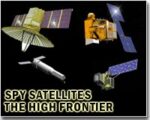Quantum Space’s modular Ranger 500 spacecraft has successfully cleared its Critical Design Review (CDR), marking a major milestone toward its first validation mission in cislunar space. Designed to enable persistent operations beyond geostationary orbit (GEO), the Ranger 500 is positioned to support future military and commercial missions in the increasingly strategic Earth-Moon corridor.
Ranger 500: A Platform for Cislunar Autonomy
The Ranger 500 is Quantum Space’s flagship spacecraft bus optimized for operations in deep space environments including cislunar orbit, Earth-Moon Lagrange points (particularly L1 and L2), and Very Low Earth Orbit (VLEO). With a dry mass of approximately 450 kg and designed to accommodate payloads up to 250 kg, the platform offers a scalable architecture suitable for ISR missions, communications relays, navigation augmentation, and logistics support.
The platform features:
- High-efficiency electric propulsion system tailored for long-duration stationkeeping at Lagrange points
- Autonomous navigation and onboard AI-based health monitoring
- Modular payload bay with standardized interfaces for rapid integration
- Radiation-hardened avionics for extended operation in high-radiation zones
The spacecraft is also designed with dual-use capabilities in mind—supporting both civil science missions (e.g., lunar observation or heliophysics) and national security objectives such as space domain awareness (SDA) or resilient comms architectures beyond GEO.
Validation Mission Targets Earth-Moon L1 Operations
The upcoming validation flight—currently scheduled for launch in late Q3 or early Q4 of 2025—will deploy the Ranger 500 into a trajectory targeting the Earth-Moon L1 point. This region offers strategic vantage points for monitoring lunar surface activity, relaying communications between lunar assets and Earth-based stations, or tracking objects moving through cislunar space.
This mission aims to validate several key technologies:
- Autonomous stationkeeping at L1 using electric propulsion
- Real-time telemetry relay from lunar vicinity back to ground stations
- Payload integration architecture supporting future SDA sensors or comms packages
If successful, this demonstration would establish Quantum’s credibility as a provider of persistent platforms for U.S. government customers such as NASA under CLPS (Commercial Lunar Payload Services), DARPA’s NOM4D program (for modular on-orbit assembly), or even future U.S. Space Force initiatives targeting deep-space situational awareness.
Cislunar Logistics as an Emerging Strategic Domain
The growing interest in cislunar space by both civil agencies and defense stakeholders reflects broader shifts in orbital strategy. The U.S. Department of Defense has increasingly emphasized the need to monitor activity beyond GEO—including Chinese lunar exploration programs like Chang’e—and ensure freedom of maneuver across all orbital regimes.
Cislunar logistics platforms like the Ranger series could serve multiple roles:
- ISR nodes with EO/IR or RF sensors monitoring lunar approaches or foreign assets
- Tactical communication relays bridging lunar surface units with terrestrial command centers
- Navigation augmentation systems supporting GPS-denied environments near the Moon
This aligns closely with recent efforts by U.S. Space Command and AFRL to develop “cislunar highway patrol” concepts that would require persistent sensor coverage across vast volumes of sparsely monitored orbital real estate.
Industry Partnerships and Modular Ecosystem Strategy
Quantum Space has adopted a modular development approach that enables rapid iteration across its product line—from smaller pathfinder vehicles like Scout-1 to larger follow-on variants such as Ranger XL. The company collaborates with multiple subsystem providers including:
- Tethers Unlimited Inc.: For water-based propulsion systems suitable for long-duration missions without toxic propellants.
- Aeon Blue Technologies: Providing radiation-tolerant avionics packages optimized for deep-space autonomy.
- SpectralNet Systems: Delivering AI-enabled onboard data processing frameworks that reduce latency during critical decision-making loops.
This ecosystem approach allows Quantum to tailor each mission profile while maintaining core platform commonality—a key advantage when addressing diverse customer needs ranging from NASA science payloads to DoD SDA sensors or commercial telecom packages looking to extend coverage into cislunar corridors.
Cautious Optimism Amid Competitive Landscape
While Quantum’s progress is notable—especially given the relatively short development timeline since its founding in late 2021—it faces stiff competition from established aerospace primes entering the same domain. Lockheed Martin’s LM LINUSS platform recently completed an autonomous rendezvous demo near GEO; Northrop Grumman continues work on its MEV/MEK servicing vehicles; Blue Origin has announced plans for Blue Ring—a multi-orbit tug capable of hosting military payloads beyond GEO.
However, Quantum appears focused on agility over scale. Its lean team structure and software-first philosophy may allow it to outpace legacy players when it comes to deploying purpose-built buses quickly into emerging orbital regimes. That said, success will depend heavily on execution during this first validation flight—particularly around propulsion reliability and autonomous stationkeeping performance at Lagrange points where gravitational dynamics are notoriously complex.
Outlook: Toward Operational Presence Beyond GEO by Late Decade
If successful in demonstrating operational viability at Earth-Moon L1 during its upcoming flight window, Quantum Space could position itself as a preferred provider of persistent platforms supporting DoD’s evolving vision of “space superiority” extending well beyond traditional orbital boundaries. With follow-on variants already under design—including higher-capacity buses capable of hosting modular robotic arms or refueling interfaces—the company aims to become an enabler of long-term infrastructure buildup across cis- and translunar domains by the late 2020s.
The validation mission will be closely watched not only by potential government sponsors but also by commercial satellite operators exploring opportunities around lunar relay services or asteroid prospecting support platforms. In either case, success would mark a critical inflection point in how industry approaches sustained presence outside Earth’s immediate gravity well—and signal that small but focused players can shape tomorrow’s strategic orbital architecture just as much as legacy primes can today.










